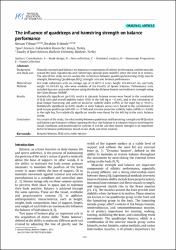| dc.contributor.author | Yılmaz, Sercan | |
| dc.contributor.author | Erdemir, İbrahim | |
| dc.date.accessioned | 2024-08-07T06:32:51Z | |
| dc.date.available | 2024-08-07T06:32:51Z | |
| dc.date.issued | 2023 | en_US |
| dc.identifier.issn | 2075-5279 / 2308-7250 | |
| dc.identifier.uri | https://doi.org/10.15561/20755279.2023.0303 | |
| dc.identifier.uri | https://hdl.handle.net/20.500.12462/14948 | |
| dc.description | Erdemir, İbrahim (Balikesir Author) | en_US |
| dc.description.abstract | Background and Study Aim Muscular strength and balance are important components of athletic performance, and the muscles around the knee (Quadriceps and Hamstrings) provide joint stability when the knee is in motion. The aim of this study was to analyze the correlation between quadriceps/hamstring (H/Q) muscle strength, Hamstring/Quadriceps (H/Q) strength ratio and balance performance.Material and Methods Ten male volunteers with an average age of 21.60 & PLUSMN;2.11 years, height 176.40 & PLUSMN;4.67 cm, and body weight 76.50 & PLUSMN;8.85 kg, who were students of the Faculty of Sports Sciences. Performance tests included dynamic and static balance using the Biodex Balance System and isokinetic strength using the Cybex Humac NORM & REG;.Results Statistically significant (p<0.05) results in dynamic balance scores were found in the correlation of H/Q ratio and overall stability index (OSI) in the left leg (r =-0.645), and in the correlation of peak torque hamstring and anterior-posterior stability index (APSI) in the right leg (r =0.671). Statistically significant (p<0.05) results in static balance scores were found in the correlations of peak torque quadriceps with OSI (r=-0.760) and anterior-posterior stability index (APSI) (r=-0.650) in the right leg. No statistically significant results were found for the left leg in the static balance scores.Conclusions As a result of the study, the relationship between quadriceps and hamstring strength and H/Q ratios and balance performance without ignoring the fact that balance is a complex feature involving the visual, vestibular, and proprioceptive systems. It can be said that muscle strength is an important factor in balance performance based on our study and other sources. | en_US |
| dc.language.iso | eng | en_US |
| dc.publisher | Iermakov S S | en_US |
| dc.relation.isversionof | 10.15561/20755279.2023.0303 | en_US |
| dc.rights | info:eu-repo/semantics/openAccess | en_US |
| dc.rights.uri | http://creativecommons.org/licenses/by/3.0/us/ | * |
| dc.subject | Dynamic Balance | en_US |
| dc.subject | H | en_US |
| dc.subject | Q Ratio | en_US |
| dc.subject | Static Balance | en_US |
| dc.title | The influence of quadriceps and hamstring strength on balance performance | en_US |
| dc.type | article | en_US |
| dc.relation.journal | Physical Education of Student | en_US |
| dc.contributor.department | Spor Bilimleri Fakültesi | en_US |
| dc.contributor.authorID | 009-0005-8005-0095 | en_US |
| dc.contributor.authorID | 0000-0002-5279-6907 | en_US |
| dc.identifier.volume | 27 | en_US |
| dc.identifier.issue | 3 | en_US |
| dc.identifier.startpage | 112 | en_US |
| dc.identifier.endpage | 117 | en_US |
| dc.relation.publicationcategory | Makale - Uluslararası Hakemli Dergi - Kurum Öğretim Elemanı | en_US |




















